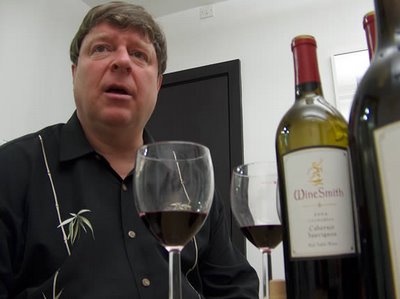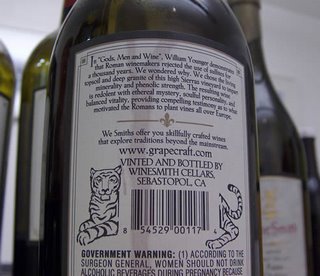Clark Smith and his Roman wine
 Last night I met Clark and Susie Smith, thus fulfilling one of my long-held ambitions. Clark is the guy behind www.vinovation.com, a hi-tech wine consulting company in California, and I've wanted to meet him ever since I wrote one of my early Harpers technical pieces where I interviewed him by phone. But he isn't advocating using technology to spoofulate wines. Seeing technology as a useful tool, he then sets about using his tool kit, which includes microoxygenation and reverse osmosis, to make more interesting and tasty wines. Not convinced? Well, I'll do a lengthy article soon on this subject, which I hope will explain what I'm getting at.
Last night I met Clark and Susie Smith, thus fulfilling one of my long-held ambitions. Clark is the guy behind www.vinovation.com, a hi-tech wine consulting company in California, and I've wanted to meet him ever since I wrote one of my early Harpers technical pieces where I interviewed him by phone. But he isn't advocating using technology to spoofulate wines. Seeing technology as a useful tool, he then sets about using his tool kit, which includes microoxygenation and reverse osmosis, to make more interesting and tasty wines. Not convinced? Well, I'll do a lengthy article soon on this subject, which I hope will explain what I'm getting at.We tasted a range of wines before dinner, including a 'sweet spot' tasting of an Amador County Syrah - the same wine at 15.4%, 14.2% and 13.75% alcohol. The differences were striking. We also tried Clark's own wines - which effectively act like business cards. WineSmith is his high end range; Cheapskate the everyday stuff. In fact, the Cheapskate wines are the best $8 wines you'll ever taste. At least that's what I reckon. After the tasting we headed over to Tendido Cero, one of my favourite eating places, where we ate and drank well (my choice - a bottle of the 2004 Finca Sandoval from Manchuela - dark, spicy and mineralic, with a bit of the new world and a bit of the old).
 Tonight's tipple is the dregs of one of the wines tried last night. It's the WineSmith Roman Syrah 2003. The remarkable thing about this wine is that it is made without any addition of sulphur dioxide, the almost universally used wine preservative. Clark explains how he made this wine on his own Grapecrafter blog:
Tonight's tipple is the dregs of one of the wines tried last night. It's the WineSmith Roman Syrah 2003. The remarkable thing about this wine is that it is made without any addition of sulphur dioxide, the almost universally used wine preservative. Clark explains how he made this wine on his own Grapecrafter blog:"To be safe, I began with a wine that could serve as its own preservative, one that would consume oxygen and oppose a microbial takeover on its own, and also a varietal type for which microbial complexity might be regarded as a plus.
I decided to work with a high altitude syrah which had a lot of reductive strength from two sources: tannin and minerality. Raw unpolymerized tannin has the ability to gobble tremendous quantities of oxygen when wine is young. A beneficial side effect of micro-oxygenation is the creation of a rich, light structure which integrates aromas. Oxygen is the wire wisk in creating a tannin soufflé. This is going to keep the wine from smelling spoiled later on when the microbes have their party.
Paradoxically, working properly with oxygen doesn't oxidize the wine -- rather it increases its ability to take up more oxygen. The chemistry of phenolic polymerization is well understood, and in this case, Vern Singleton's 1986 paper on the vicinyl diphenol cascade explains why polymerizing tannins become more reactive than their precursors. "
It's a really thought-provoking wine. There's some aromatic purity and elegance, with sweet dark fruits that have a brooding depth to them. The palate is very unusual and interesting. It's expressive and angular, with firm tannins and a meaty, spicy sort of rasp. These jostle with some funkier, herby, tobbacoey sort of elements. It finishes savoury and spicy. It's a wine that seems to show you one thing and then another. It's not a wine for everyone: some will find these bold, savoury flavours just a little too dangerous. But I like it a good deal.
Labels: california, dinners, spain, wine science


19 Comments:
Am interested in the Finca Sandoval - how much is it? Who makes it? Have just finished reading your mercaptan article (Harpers deliveries have been problematic of late - and I have missed some from Sept.) Are all thiols mercaptans or vice versa? Only thiols are very much ahot topic around town these days...
Sorry - not really anonymous - and I am using one arm... Got through two issues of Harpers while waiting on a new cast for my shattered wrist. At least we do have a public health system I guess..
Paul
you certainly have a nack with your camera Jamie,of making reasonably good looking men,look ---well not so good.!!
As for fiddling with wine--surely Rolland and others have been doing this for sometime,so if the Smith wines taste good,I would certainly buy them.
Paul, how did you shatter your wrist? Sounds nasty - hope you have a speedy recovery.
Sandoval is made by Spanish journalist Victor de la Serna - it's impressive stuff - retails for about £18 in the UK (in the restaurant it was £48) from haynes, hanson & Clark.
Thiols = mercaptans
Keith, Clark is interesting because he has an interesting philosophy of wine. He doesn't try to spoofulate the wine.
I have a question:
Typically it is the formation of chemical bonds that requires energy and the breaking of chemical bonds that releases energy.
So, why is it that so much polymerisation (forming bonds) of sugars and tannins happens in a wine bottle?
Keith, do you know of any good examples of wine spoofulating in south Africa?
further to this, would be great to meet up and have a glass of wine here in sunny Cape Town - if the offer is still out there?
Jamie, you say "he isn't advocating using technology to spoofulate wines" but surely MRDA (Mandy Rice Davis Applies) here. Is there really anyone (as Cru master suggests) to deliberately sets out to "spoofulate"????
Surely it's used as a way of making wine taste "nicer" in order to increase sales/profitability.
"Football".
Have been explaining to most of the doctors an nurses what that game is. Apparently soccer injuries are moe prevalent in NZ than rugby ("union", thst is, am a league man myself).
Was playing in a mixed seven a side tournament to raise money for the Samoan Football Assoc (wonder what "beautiful game" is in Samoan.)
Unlike Guus Hiddinck, I believe it is important to promote the sport in the Pacific Islands (another reason we did not support Australia in the recent World Cup.)
Alex, you've hit on an interesting point which deserves its own essay. In brief, tools are neutral; they can be harnessed in the service of goals that are not neutral, though. I think Clark has a philosophy that genuinely seeks to make interesting wine, hence to Roman wine project. Or, perhaps, there's some complex psychology going on here, based around deep feelings of guilt. Who knows?
Stephen, it's to do with the fact that bottled wine hasn't reached equilibrium yet. Reactions proceed.
' Keith Prothero said...
you certainly have a nack with your camera Jamie,of making reasonably good looking men,look ---well not so good.!!'
I disagree!
I think Jamies photographs are all round impressive, expressive, of their subject, terroir even!
I find it interesting that a blog on Clark Smith suddenly generates plenty of interest.
As a wine critic (and a sometime wine educator), I have concerns about tyhe implied priniciples of his work, for instance the "sweet spot" wines. There is no absolutist measure of wine quality - because quality is ineluctably bound up in wine style. Yet Vinovation's work is in demand because clients want the high scores. I recently stopped scoring wines, which annoyed my publisher, but as the first Kiwi to use the hundred point system, some ten years ago, I found that the usefulness of that point scale had passed. Many of my colleagues now use it - and the critical distinctions of my scores were passing most punters by.
I am sure Clark is a cool dude - and his work is interesting - but I think there are more worthy disciplines to improve wine quality which we need to promote. Vinovation sounds to me like an extension of the flavour profile modelling / consumer preference analysis work that Jane Robichaud started 15 years ago. I am not sure that Robichaud ever truly succeeded and so I am not sure where this is going either!
Call me a traditionalist (except when it comes to closures!)
Yours in great agony her,
Paul
PS Te Mata Estate have been releasing some of their top wines without sulphur addition for years - some of the best sans souffre wines I have ever tasted
Cru Master, You have my number so please give me a call,or give me yours.
spoofulating in the Cape -surely not!!
Anonymous - I think Keith's still smarting from one that Jamie took of him that wasn't particularly flattering.
Terroir in photography - now that's a fun idea!
http://www.wineanorak.com/blog/
uploaded_images/
keith_protheroe-741829.jpg
Jamie said...
http://www.wineanorak.com/blog/
uploaded_images/
keith_protheroe-741829.jpg
11:37 AM
Dig the guinea fowl roasting in the background......must be Bandol in them plastic cups.
To Paul Tudor:
I'm not sure why the connection gets made between what we do and the reductionist dribble Jane Robichaud preaches. We are all about technique, and will use new or old tools as needed to bring a wine into balance, trying to be primarily mindful of protecting its uniqueness. Jane and others stamped from the Ann Noble mill, together with her nemesis Leo McCloskey, seek to reverse engineer wine through multivariate reductionism. Jane got traction at Beringer because 1)their corporate managers wanted a way to manage quality without having to taste and assess the wine, and 2) they liked it when her experiments didn't show anything, because then they didn't have to spend any money. I went on record in 1995 (http://www.winecrimes.com/winecrimes/UC_deliciousness.pdf). that the V&E Department at Davis was on the wrong course. I wish you wouldn't paint me with that particular brush. My true evils can be explored at winecrimes.com.
For Stephen I'll mention that polymerization of flavonoids is clearly energetically favored. They're very interesting compounds, and often show counterintuitive behavior. You can observe how they work in bananas or apples to seal an injury through browning, which is a sure sign of polymerization. In wine we want to minimize this -- to make short chains so their cooperative binding interaction with salivary protein is minimized. Active color is the key -- it terminates polymerization. That's why syrah always seems soft, but pinot can dry out -- it's the poor color. More about all this on my blog at www.grapecrafter.com, or if you want to get heavy, check out http://www.vinovation.com/MOxtheory.htm.
Wow. I feel I am at a roadhouse, or bar, in a company town. This blog has some problems. It references people, places and things that require too much inside knowledge for me average winemaker. It slams people, places and things. It does not respect people, places and things. Who are your leaders?
Really.... Paul Tudor you are a dried up wine writer that seems to have no credibility in New Zealand. Sporadic publishings mean very little to a wine consumer or anyone that appreciates wine for that matter. Probably best you stay with Tonkin Taylor in the library area you currently work.
Post a Comment
Links to this post:
Create a Link
<< Home